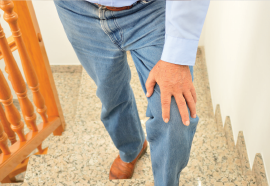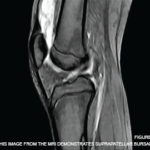
ESCEO recommends systematic repeated intra-articular hyaluronic acid injections as second-line treatment for patients with knee OA.
cunaplus/shutterstock.com
An international task force convened by the European Society for Clinical and Economic Aspects of Osteoporosis and Osteoarthritis (ESCEO) recommends systematic repeated intra-articular hyaluronic acid (HA) injections as second-line treatment for patients with knee osteoarthritis (OA). This is the first time a group of experts has made this recommendation, which is directed toward treatment of patients who have had a beneficial response with a previous cycle of treatment.1
The review article highlights the safety profile of the treatment and its “moderate but real” efficacy on symptoms. The efficacy of intra-articular HA, according to the review, is in the same range as other pharmacologic modalities used for knee OA, but does not have the vascular and gastrointestinal toxicity of acetaminophen and non-steroidal anti-inflammatory drugs (NSAIDs) or the adverse events associated with corticosteroid injections in some patients.
The ESCEO task force recommends that intra-articular HA be used in patients who remain symptomatic despite continuous or intermittent treatment with conventional pharmacologic treatment modalities, such as acetaminophen, symptomatic slow-acting drugs and NSAIDs, and in patients with comorbidities that preclude the use of NSAIDs. The evidence for this recommendation was drawn from real-life clinical data.
“The medical community cannot afford to neglect the use of [intra-articular] HA, particularly now that systematic repetitive treatment cycles have been shown to yield positive results in terms of both efficacy and safety,” the task force members said. The review “encourages the use of repeated cycles of [intra-articular] HA in patients who responded to the first injection, starting a new treatment cycle as soon as the first symptoms appear.”
Additionally, the task force found no current clinical evidence supporting an advantage in efficacy of one intra-articular HA product over another. If intrinsic properties of a product, such as its molecular weight, provide a beneficial result when compared with other intra-articular HA products, “characteristics related to the patient are likely to prevail,” the authors said.
Professional Guidelines
The task force notes that other professional groups have weighed in on the efficacy of intra-articular HA for treatment of knee OA. “However, while IAHA was initially clearly recommended by national and international professional societies, such as the Osteoarthritis Research Society International (OARSI), the European League Against Rheumatism (EULAR) and the [ACR], some clinicians, researchers and decision makers feel that current guidelines are conflicting and less favorable than 10 years ago,” the review states.
Recent guidelines offer varying recommendations on intra-articular HA for knee OA. David Felson, MD, MPH, professor and director of the Clinical Epidemiology Research & Training Unit at Boston University School of Medicine, says, “The Osteoarthritis Research Society, which conducted a systematic review of the HA literature, gave it an ‘uncertain’ recommendation and stated it was ‘not appropriate’ for multiple-joint OA. No other major guidelines, such as ACR or AAOS [American Academy of Orthopaedic Surgeons], support the use of [intra-articular] HA. [Although] published trials from industry have been positive, suggesting efficacy, meta-analysts have uncovered large unpublished trials that showed no efficacy of HA,” Dr. Felson says.
Among the guidelines on the use of IAHA are those from the National Institute for Health and Care Excellence (NICE). Its 2014 clinical guidelines for care and management of OA state that HA injection should not be offered for OA management.2
The ACR recommendations, published in April 2012 in Arthritis Care & Research, give a conditional recommendation for IAHA use in patients who have had an inadequate response to initial therapy.3 The initial pharmacologic therapies conditionally recommended by the ACR include acetaminophen, oral and topical NSAIDs, tramadol and intra-articular corticosteroid injections. The expert panel conditionally recommended the use of tramadol, duloxetine or IAHA injections in patients older than 75. The ACR makes no recommendation regarding the use of HA for initial management of knee OA.
EULAR recommendations issued in 2003 support the efficacy of HA for management of knee OA for pain relief and knee functional improvement, a recommendation supported by level 1B evidence.4 The guidelines released by OARSI in 2014 in Osteoarthritis and Cartilage take a similar stand to the ACR and provide an “uncertain” recommendation for IAHA for patients with knee-only OA.5 One meta-analysis, according to the OARSI guidelines, raised some safety and efficacy concerns about the therapy, but “a number of analyses revealed positive effects for pain.”
The OARSI guidelines indicate that there is a role for physician–patient interaction to determine whether IAHA may have some merit in the context of its risk–benefit profile and the patient’s characteristics, comorbidities and preferences. AAOS released a revised clinical practice guideline for knee OA in 2013, stating that IAHA is no longer recommended for symptomatic OA of the knee.6 That statement noted that individual studies had found statistically significant treatment effects, but that when the evidence was combined in a meta-analysis, the evidence did not meet the “minimum clinically important improvement thresholds.”
A workgroup of clinical experts developed an Appropriate Use Criteria (AUC) for IAHA treatment of knee OA, published in Cartilage in 2016, that outlined appropriate, uncertain or inappropriate patient scenarios for use of IAHA. Six were scored as appropriate, 10 as uncertain, and one as inappropriate.7 The six clinical scenario for appropriate use include symptomatic adults with mild or moderate OA of the knee who have clinically and radiologically confirmed disease who have not received other therapies for the knee, have failed other nonpharmacologic or pharmacologic therapies for the knee or have had an incomplete response to other therapies for the knee.
The task force contends that IAHA “is not a panacea for treating a heterogeneous disease such as knee OA.” However, because knee OA mostly affects the elderly and patients with significant comorbidities and with conditions that can restrain the use of several conventional therapeutics, IAHA can be a “key weapon in the therapeutic armamentarium for managing knee OA in patients with contraindications to conventional interventions.”
Kathy Holliman, MEd, has been a medical writer and editor since 1997.
References
- Cooper C, Rannou F, Richette P, et al. Use of intra-articular hyaluronic acid in the management of knee osteoarthritis in clinical practice. Arthritis Care Res (Hoboken). 2017 Jan 24.
- National Institute for Health and Care Excellence (UK). Osteoarthritis: Care and management in adults. NICE Clinical Guidelines, No. 177. 2014 Feb.
- Hochberg MC, Altman RD, April KT, et al. American College of Rheumatology 2012 recommendations for the use of nonpharmacologic and pharmacologic therapies in osteoarthritis of the hand, hip, and knee. Arthritis Care Res (Hoboken). 2012 Apr;64(4):465–474.
- Jordan KM, Arden NK, Doherty M, et al. EULAR Recommendations 2003: An evidence based approach to the management of knee osteoarthritis: Report of a Task Force of the Standing Committee for International Clinical Studies Including Therapeutic Trials (ESCISIT). Ann Rheum Dis. 2003 Dec;62(12):1145–1155.
- McAlindon TE, Bannuru RR, Sullivan MC, et al. OARSI guidelines for the nonsurgical management of knee osteoarthritis. Osteoarthritis Cartilage. 2014 Mar;22(3):363–388.
- Brown GA. AAOS clinical practice guideline. Treatment of osteoarthritis of the knee: Evidence-based guide. 2nd edition. J Am Acad Orthop Surg. 2013 Sep;21(9):577–579.
- Bhadra AK, Altman R, Dasa V, et al. Appropriate use criteria for hyaluronic acid in the treatment of knee osteoarthritis in the United States. Cartilage. 2016 Aug 10.


